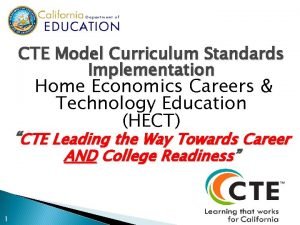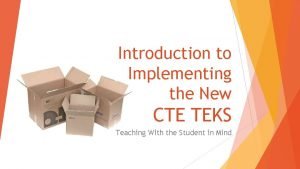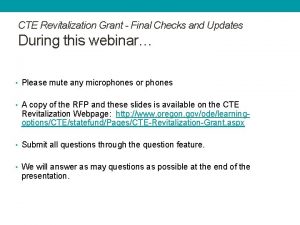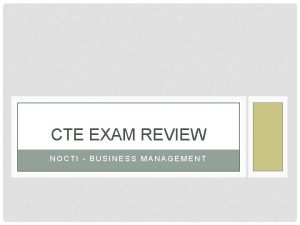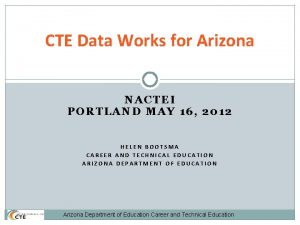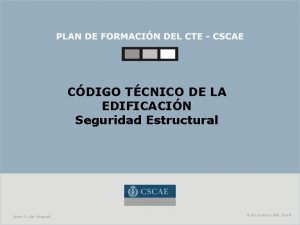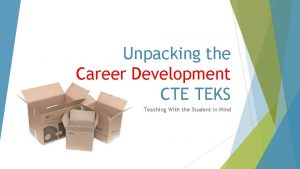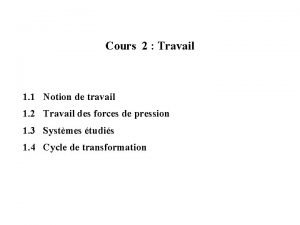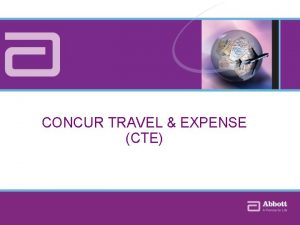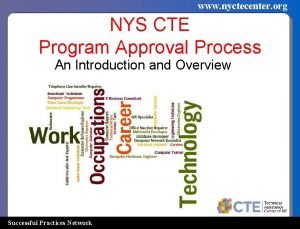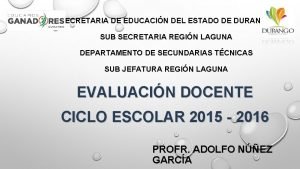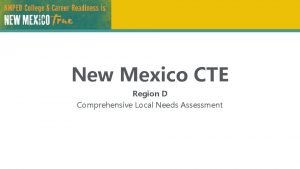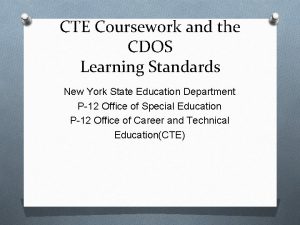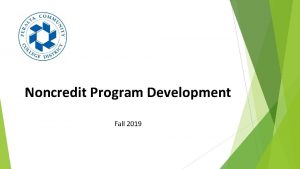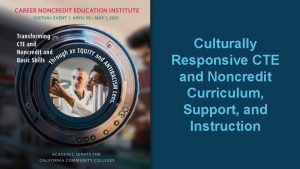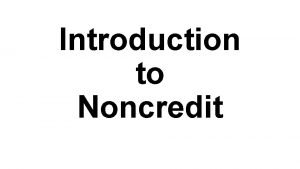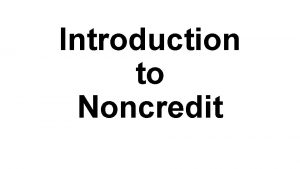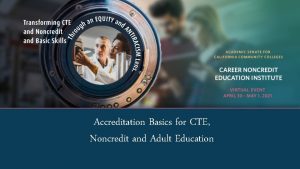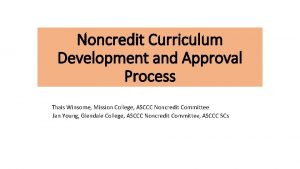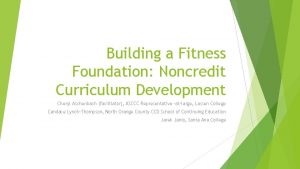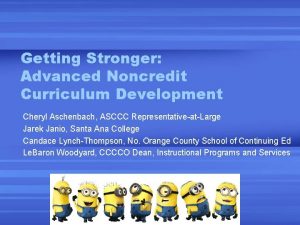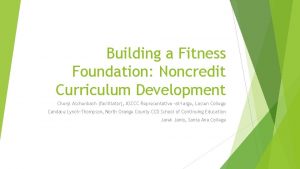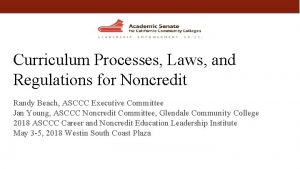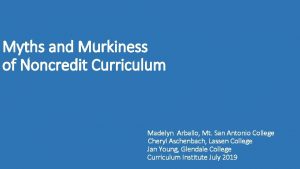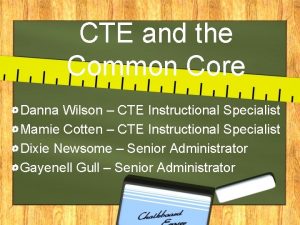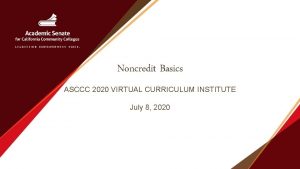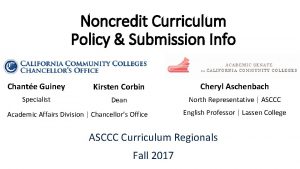Curriculum Development for Noncredit and CTE Through an

















- Slides: 17

Curriculum Development for Noncredit and CTE Through an Equity Lens Saturday, May 1, 2021 2: 00 p. m. to 3: 00 p. m. Breakout Session 6

Dr. M. Leonor Cadena, NOCCCD Diversity & Inclusion Faculty Fellow mcadena@fullcoll. edu Presenters Raine Hambly, NOCE Director Career Technical Education rhambly@noce. edu Dr. La. Tonya Parker, ASCCC Equity and Diversity Action Chair latonya. parker@mvc. edu Dr. Kimberley H. Stiemke, ASCCC Noncredit & Basic Skills Committee kstiemke@noce. edu 2

Session Description Through an equity lens, participants will explore curriculum approaches that build student agency and address teachers' beliefs and mindsets in Noncredit and CTE courses. 3

Take Aways • • Greater understanding of equity Reflect on current practices Spark conversation Develop and advance DEIA and social justice in the classroom DEIA - Diversity, Equity, Inclusion, and Anti-Racism 4

Icebreaker What color is the dress? Please type your response in the chat. 5

This is Equity Share at least one take away, “aha moment”, from the video by writing it in the chat. 6

What is equity? • Equity is the fair treatment, access, opportunity, and advancement for all people, while at the same time striving to identify and eliminate barriers that have prevented the full participation of some groups. • Improving equity involves increasing justice and fairness within the procedures and processes of institutions or systems, as well as their distribution of resources. • Tackling equity issues requires an understanding of the root causes of outcome disparities within our society. https: //independentsector. org/resource/why-diversity-equity-and-inclusion-matter/ 7

The District Scenario The District has funds to purchase 100 new computers for student use to be split between College A and College B. College “A” and “B” have the same number of students, but College “A currently has 20 computers and College “B” currently has 60 computers. What is an equal distribution of the 100 new computers? What is an equitable distribution of the 100 new computers? 8

What is Equity-Mindedness? • The term refers to the perspective or mode of thinking exhibited by practitioners who call attention to patterns of inequity in student outcomes. • These practitioners are willing to take personal and institutional responsibility for the success of their students, and critically reassess their own practices. • It also requires that practitioners are race-conscious and aware of the social and historical context of exclusionary practices in American Higher Education https: //cue. usc. edu/about/equity-mindedness/ 9

Recognizing Obstacles to Equity-Mindedness The English department chair at Anywhere College notices that a large number of African American & Latinx students who are placed in the departments basic skills English/Writing courses do not proceed to credit-level courses. She provides the data at a department meeting for discussion. One faculty member says. “This has nothing to do with race. ” Other say, “I teach students. I don’t care whether they are white, black, or purple. ” or “Maybe these students are not predisposed to doing well in English because their brains are not wired that way” Identify the obstacle most relevant to this scenario 1. Claiming to Not See Race or Skirting Around Race 2. Not Being Able or Willing to Notice Racialized Consequences 3. The Pervasiveness of White Privilege & Institutionalized Racism 4. The Myth of Universalism 5. Seeing Racial Inequities as a Reflection of Academic Deficiency 10

What does it mean to be an “equity-minded practitioner”? • Evaluate their practices for effectiveness • Recognize inequity as something they can control • Question their assumptions • Recognize stereotypes that hinder student success • Fix what is broken • Hold themselves accountable for student success • https: //cue. usc. edu/about/equitymindedness/ 11

How would an equity-minded practitioner approach this opportunity? • The English department chair at Anywhere College notices that a large number of African American & Latinx students who are placed in the departments basic skills English/Writing courses do not proceed to credit-level courses. She provides the data at a department meeting for discussion. One faculty member says. “This has nothing to do with race. ” Other say, “I teach students. I don’t care whether they are white, black, or purple. ” or “Maybe these students are not predisposed to doing well in English because their brains are not wired that way” 12

What Makes a Course Equity-Minded? • Equity is embedded in the course design from start to finish. It is reflected in every aspect of the course including but not limited to the title, description, learning outcomes, and theoretical perspective. • Incorporate the identities and lived experiences of students who have been disproportionately-impacted in education. • Prioritizes community and collaboration as opposed to competitiveness. • Students and instructors have opportunities to learn from each other. • A variety of strategies are used to assess student learning. Adapted from the work of Frank Harris III 13

What Makes a Course Equity-Minded? (cont. ) • A variety of pedagogies are used to address a range of learning strengths and styles. • Content is relevant and facilitates real-world problem-solving. • Relationship building, intentional outreach, validation, humanizing practices, and race consciousness are embedded in the course. • Critical resources are made available at the start of the course. • Course policies relating to grading, attendance, participation, required texts, and the submission of assignments do not disadvantage disproportionately impacted students. Adapted from the work of Frank Harris III 14

Areas for Inquiry • • • Title Course Description Learning Outcomes Assessments Discipline Grading Resources Theoretical Perspectives Syllabus 15

Questions 16

Resources • https: //independentsector. org/resource/why-diversity-equity-andinclusion-matter/ • https: //cue. usc. edu/about/equity-mindedness/ 17
 Cte anchor standards
Cte anchor standards Conversion of timber advantages and disadvantages
Conversion of timber advantages and disadvantages Through one man sin entered
Through one man sin entered Classes of furcation
Classes of furcation Night of the scorpion story
Night of the scorpion story Cte meaning
Cte meaning Cte revitalization grant
Cte revitalization grant Nocti general management study guide
Nocti general management study guide Cte technical skills assessments.azed.gov/student
Cte technical skills assessments.azed.gov/student Cte seguridad estructural
Cte seguridad estructural Afnr teks
Afnr teks Travail
Travail Oneconcur abbott
Oneconcur abbott Nysed cte approved programs
Nysed cte approved programs Plataforma cte durango
Plataforma cte durango Cte school new mexico
Cte school new mexico Cargas muertas cte
Cargas muertas cte Cte programs of study
Cte programs of study
